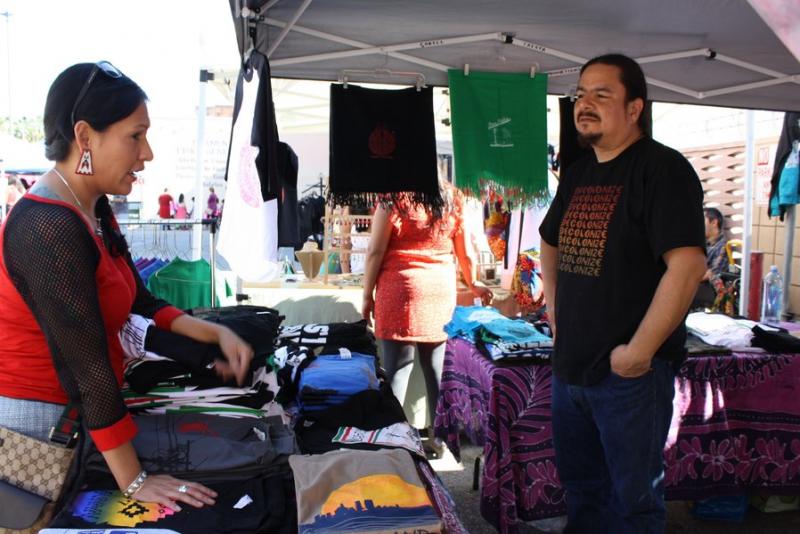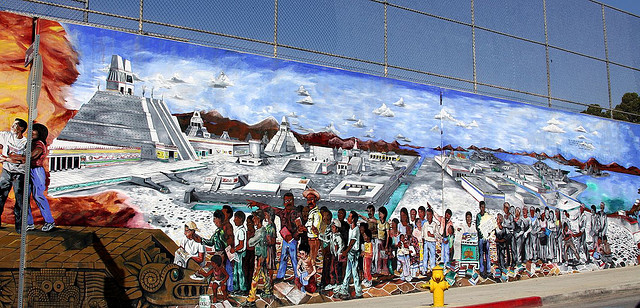Boyle Heights Residents Fight For Community And Art

Dewey Tafoya, an artist who was born and raised in Boyle Heights, remembers when the neighborhood looked even more rundown than it is today, “When we were kids...it was more like, ‘what we’re going to do to get the fuck out of here?’”
Boyle Heights has been, historically-speaking, a neighborhood of many ethnicities ranging from Mexican to Japanese. Today, Boyle Heights is home to a high hispanic and latino population, most of whom are of Mexican origin. The poverty rate is 33% as opposed to all of L.A.’s 22%, and the median income is $33,200 as opposed to the city’s $53,000. Its crime rate has also given Boyle Heights a reputation for being a “tough customer” East L.A. neighborhood.
But Boyle Heights is attracting attention from outside of its borders with its vibrant art culture, which ranges from murals to poetry to music to theatre. Joel Garcia of Self-Help Graphics emphasized that art is a huge part of Boyle Heights because much of its art, particularly its murals, reflect the social justice issues and cultural aspects surrounding the community. This sort of art is different from any other in Los Angeles, Garcia said, because of the community surrounding it, and that it “speaks a lot to identity.”
As more people travel to Boyle Heights to experience the art, developers such as the L.A. County Metro see potential in creating new spaces that would bring even more people to the area. But with empty lots bought by Metro and the hassle of using the iconic Mariachi plaza stage for an event, people in Boyle Heights doubt the benefits of corporate vision.
“It’s a real insult to the community,” says Catherine Kurland, author of Hotel Mariachi, “to propose a 5-story parking garage and shopping center with a gym and other facilities that has nothing to do with the community and that they can’t afford to use.”
READ MORE: Five Years On, Small Businesses Struggle To Recover From Gold Line Construction

“People need to understand that we don’t need to have [newcomers setting up businesses]*,” said Acevea, whose family has been in Boyle Heights for 60 years. “We need to look out for our own*...Win or lose, we’re here to fight.”
And people in Boyle Heights are fighting back beyond protests by turning to younger generations to ensure that Boyle Heights’ art culture retains its uniqueness. Educators, academics and artists like Tafoya are working with students in the community to teach them about gentrification and to get them interested in shaping what Boyle Heights will look like in the future. The future the kids wanted, according to Tafoya, includes more opportunities for jobs in the area.
There are “definitely many [business] opportunities” in Boyle Heights, Kurland said. The key thing potential developers need to take into consideration, Kurland said, is the voice of the community and how its art will be affected by new developments. She pointed to Libros Schmibros, a lending library that opened in 2010 and promotes literacy in the neighborhood and humanities advocacy, as a community-based business.
Tafoya also sees opportunities for Boyle Heights, but emphasizes that newcomers need to recognize the pride in the community.
“I’m an artist who works in a lot of different communities in Los Angeles,” Tafoya said, “and my first key thing is you don’t diss somebody’s neighborhood.”
This particular East L.A. neighborhood isn’t some new place, Tafoya said. Residents have a strong connection to the history of Boyle Heights. Their pride in its art, its community and its past keeps them fighting to keep developers from displacing the people of the neighborhood and eliminating the culture that makes Boyle Heights unique.
*Edit Note: Acevea was quoted out of context. He did not imply that Boyle Heights didn't need new business, and the nessecary edits were made.
Contact Staff Reporter Heidi Carreon here and follow her on Twitter here.



